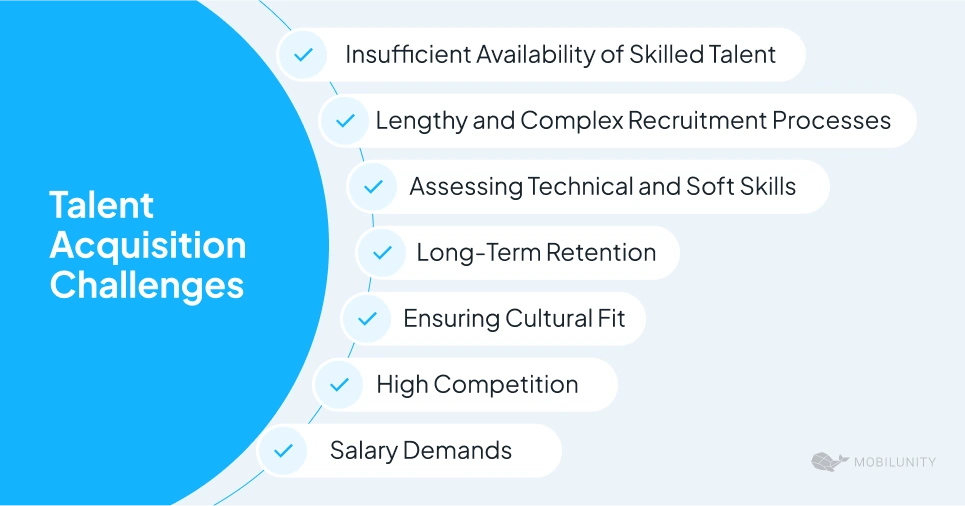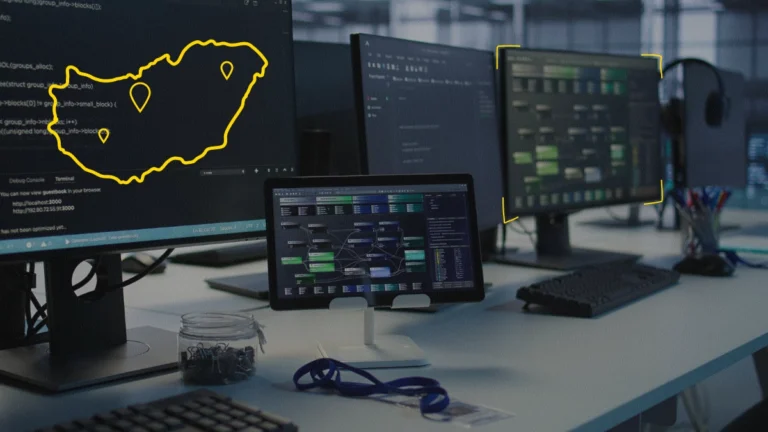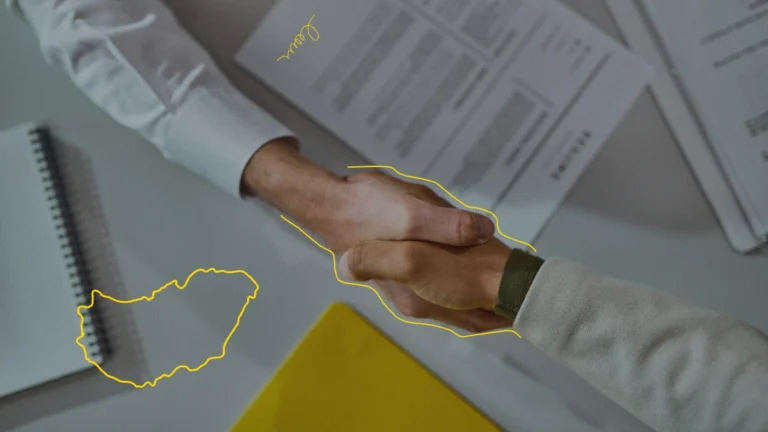Hiring Software Developers: Top Challenges and Solutions for Your Project
- Challenge 1: Insufficient Availability of Skilled Developers
- Challenge 2: High Competition and Salary Demands
- Challenge 3: Lengthy and Complex Recruitment Processes
- Challenge 4: Assessing Soft / Tech Skills
- Challenge 5: Ensuring Long-Term Fit & Retention
- Mobilunity’s Best Practices to Cope With Software Developer Hiring Challenges
- Conclusion: Best Way of IT Recruitment
In today’s rapidly evolving tech landscape, the demand for skilled software engineers has never been higher. Many companies are racing to innovate their products, doing their best to secure top talent in an increasingly competitive market. Most recruiters and CIOs surveyed by Gartner (86%) confirm increasing competition in IT recruitment, expecting this trend to persist in the coming years.
In this article, we’re going to explore the biggest challenges of hiring software engineers, offering actionable insights and practical recommendations from our expert recruiters. We’ll discuss common issues such as talent availability, lengthy talent acquisition processes, the difficulty of assessing both soft / tech skills, and some others. With proven best practices, you’ll be able to navigate the complexities of hiring much easier.

Challenge 1: Insufficient Availability of Skilled Developers
The global demand for skilled software engineers continues to outpace supply. This obviously leads to a significant shortage of professionals with advanced tech skills. This shortage is particularly noticeable in specialized areas for hiring a software developer, such as Go, Scala programming language, and full-stack software development, where the expertise required is rare and highly technical.
That’s why finding candidates who possess both deep technical knowledge and the right cultural fit for an organization is a daunting task. Additionally, specialized skill sets are often concentrated in a few geographic regions, forcing companies to compete globally for the same limited pool of experts. Delays in hiring the right talent can slow down software development cycles, increase cost of hiring, and ultimately hinder your ability to stay competitive. In such an environment, it is important to have a strategic approach to talent acquisition – today it should go beyond traditional recruiting methods.
Challenge 2: High Competition and Salary Demands
The lack of skilled talents doesn’t end here – tech industry giants and startups alike are competing for highly skilled professionals. This often results in aggressive salary offers and extensive benefits packages. The competition drives up salary expectations, making it increasingly challenging for many projects to attract and retain the best talent without ruining their budgets.
High competition not only forces companies to offer premium compensation. As multiple organizations target the same candidate, this can lead to the risk of losing potential hires to competitors who make faster decisions / offer better deals. This environment forces companies to rethink their strategies and look for innovative solutions that allow them to remain competitive without overspending. And the dynamic nature of the market pushes modern strategies to be both agile and cost-effective.
Challenge 3: Lengthy and Complex Recruitment Processes
Traditional talent acquisition methods often involve multiple stages of screening, interview challenges, and administrative procedures that can stretch your hiring process over several months. In many organizations, the process begins with an extensive job posting, followed by a manual review of hundreds of applications. This initial screening is often time-consuming and may result in delays – that allow top candidates to lose interest or accept different offers from your competitors.
Once a shortlist is created, coordinating interviews between potential candidates, technical teams, and HR representatives can be a complex logistical venue. Scheduling catch-ups, prolonged feedback loops, and iterative rounds of interviews further extend the time-to-hire. In today’s competitive market, the window for securing top talent is narrow, and extended hiring timelines surely lead to missed opportunities. Moreover, lengthy processes often involve multiple stakeholders, each with their own priorities and scheduling constraints, adding layers of complexity. The administrative overhead associated with such processes also drains valuable resources from the core business, reducing overall efficiency.
Challenge 4: Assessing Soft / Tech Skills
One of the biggest difficulties in hiring good software engineers is accurately assessing both their technical expertise and their communication and collaboration skills. Traditional hiring methods often rely too heavily on CVs or generic coding tests – they only provide a limited view of a developer’s capabilities. While a CV might list relevant technologies and projects, it rarely reflects how a candidate performs in a real-world setting or how well they work within a team. Coding tests, on the other hand, can be overly simplistic and fail to capture a developer’s ability to solve complex problems / adapt to dynamic environments.
Evaluating technical skills requires a deep dive into a candidate’s ability to handle specific tests that are representative of your project needs. It’s important to assess not only the theoretical knowledge but also their practical problem-solving abilities. Equally important are soft skills. Effective communication, teamwork, and cultural fit can significantly impact the success of a project. The candidates may be technically brilliant, but if they struggle to communicate ideas or work collaboratively, the overall team productivity will suffer. Assessing these skills often requires an even more comprehensive approach.
Challenge 5: Ensuring Long-Term Fit & Retention
When candidates are a good cultural fit, they can integrate seamlessly into your existing workflows and contribute positively to team dynamics. This alignment goes far beyond technical skills – it’s all about values, communication styles, work ethics, and the ability to collaborate effectively. Mismatches can lead to common challenges, such as misunderstandings, conflicts, and ultimately, higher turnover rates. High employee turnover can not only disrupt your project continuity but also drives additional costs in recruiting, training, and lost productivity. Moreover, cultural misalignment can impact team collaboration, slow down decision-making, and create a fragmented work environment – which in turn affects the overall performance of your project.
To address these potential issues, Mobilunity recommends implementing a multifaceted approach during the hiring process:
- Clearly articulate your culture and company values in job postings and during initial discussions, setting the right expectations from the start
- Use structured behavioral interview questions and scenario-based assessments to evaluate a candidate and determine how well they align with your culture
- Include team-based exercises or group interviews can provide additional insights into a candidate’s collaborative style and interpersonal skills
- Engaging existing team members, team leads, executives in the hiring process can ensure a successful match.
Mobilunity’s Best Practices to Cope With Software Developer Hiring Challenges
You can effectively overcome common talent acquisition challenges and build a high-performing team that drives innovation and success. Consider implementing the following recommendations. These strategies can not only improve the quality of your new employees – but also help you find the right people quicker, secure the best specialists, and ultimately achieve a competitive edge in the tech landscape that keeps to evolve.
Define Clear Role Requirements and Expectations. Begin by crafting detailed job descriptions that clearly outline the responsibilities, required technical skills, and soft skills necessary for the role. This step minimizes misunderstandings and ensures that both the hiring team and candidates are aligned on expectations from the start. It helps to attract the best candidates who are truly a fit for your technical environment and company culture.
Optimize Job Postings. Write clear, detailed job descriptions that not only outline technical requirements but also highlight your company culture and growth opportunities. This helps attract candidates who are both technically qualified and a good cultural fit.
Invest in Employer Branding. Build a strong employer brand that reflects your company’s values, culture, and mission. Showcase success stories, employee testimonials, and your unique work environment on your website and social media to attract talent organically.
Engage with Developer Communities. Participate in hackathons, coding competitions, and tech meetups to build relationships with great developers. By being active in these communities, you can tap into a network of passionate professionals who are interested in your company’s remote work.
Offer Competitive Compensation and Benefits. Regularly review job market salary benchmarks and enhance your benefits package to remain competitive. Consider flexible working arrangements, professional software development opportunities, and a positive work culture for hiring top talent.
Create Clear Career Progression Paths. Create robust career plans for software development specialists that demonstrate long-term growth within your organization. This helps in retaining talent and reducing turnover, as employees see a future for themselves in your company.
Use Employee Referral Programs. Encourage your current employees to refer qualified candidates by offering referral bonuses or other incentives. This strategy often leads to high-quality employees who are already somewhat familiar with your company culture.
Conclusion: Best Way of IT Recruitment
These remote hiring challenges require a strategic and holistic approach. As we’ve explored, tech companies face significant difficulties – from the scarcity of specialized software development talent and fierce competition driving up salary demands, to lengthy, complex process of hiring that risk losing top candidates. Moreover, assessing both technical and soft skills in a meaningful way remains among the key challenges. Ensuring cultural match and long-term retention is essential too. These can prolong project timelines, increase costs, and ultimately hinder your competitive edge.
At Mobilunity, we know how to tackle all of these. Our recruitment expertise is built on decades of experience, an extensive global network, and rigorously refined processes – designed to give you the very best talent.
- We address talent scarcity by tapping into a global market, ensuring that your team is strengthened by experts with diverse backgrounds
- Our streamlined recruitment process significantly reduces time-to-hire, minimizing the risk of losing top candidates to competitors
- With our rigorous multi-step evaluation methods and technical interview services, you can be confident in the tech proficiency and specific skills of every candidate we deliver
- Our dedicated account managers maintain transparent communication and ongoing HR / legal / admin support, fostering long-term retention and seamless integration of new people into your team.
By partnering with Mobilunity, you’re not only solving immediate recruitment complexities but also investing in a future-proof talent acquisition that drives innovation. Take the next step toward building a high-performing, agile team that can overcome the complexities of today’s recruiting and hiring. Ready to find and secure top software engineers for your project? Tell us about your needs and get the best IT recruitment services that make a difference.













